On and Off the Beaten Path: Suchitoto
Today we are not winding down the hill below Suchitoto to catch a boat on the shore of Lago Suchitlán. Today we are not going to hear a grandfather's story while bumping along on the road between Aguilares and Suchitoto. I realized today that Suchitoto appears as a character in several of my stories, but never as the main character. So today, it's time to actually go to Suchitoto.
 |
| Central Plaza in Suchitoto (©2023 Linda Muth) |
The city of Suchitoto is situated between the Guazapa volcano and the Lempa River valley, on the western edge of the Department of Custcatlán. The name "Suchitoto" originates from a Nahuat word meaning "bird-flower." Archeologists believe the town was established as a Pipil (indigenous) settlement in the mid-11th century CE. Near to the city (and within the Suchitoto municipality), Spanish colonizers established what is known as the second "Villa de San Salvador" (the capital of San Salvador) in 1528 CE. Although the town is nestled among hills about 1000 feet above sea level, it is quite warm and not often breezy. It is believed that due to this slightly unfavorable climate, the Spanish moved the capital, San Salvador, to its current location. (Pro-Tip: When in Suchitoto, carry water and wear a hat.)
 |
| Turn a corner, and find a little shop popping with color. (©2023 Linda Muth) |
Today, the city of Suchitoto is known as a fine example of a town with historic, colonial architectural features. Visitors can wander along the cobblestone streets near the center of town and appreciate the traditional homes with clay roof tiles, carved wood shutters and doors, and balconies. Guided tours are available, or you can wander in any direction from the newly refurbished central square. The plaza is constructed in typical colonial fashion, bordered by Santa Lucía Catholic Church, restaurants, shops, open market stalls and boutique hotels.
 |
| A small hotel located just off of the main square with comfortable rooms, great breakfast and lovely staff. (©2023 Linda Muth) |
 |
| Walk along and something beautiful might just catch your eye. (©2023 Linda Muth) |
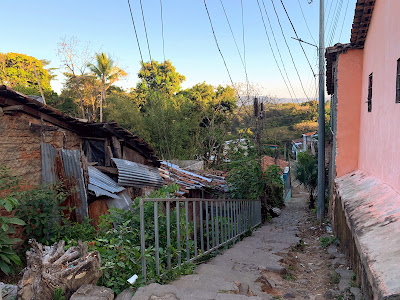 |
| Off the beaten path (©2023 Linda Muth) |
 |
| Bars and restaurants are hopping at night, especially on weekends and holidays. With a little daylight you can appreciate their artistic features. (©2023 Linda Muth) |
During the Salvadoran Civil War (1980-1992), the people of Suchitoto suffered greatly. The region around Guazapa and Suchitoto was a stronghold for the FMLN, and many families still carry experiences of trauma which they suffered as combatants or citizen victims of the conflict. The population of the municipality decreased by two thirds during the war, as people fled. With an intentional focus on the arts as providing pathways to building peace and healing, Suchitoto has grown in population and wellness.
The Art Center for Peace was established in 2005 on the site of a Dominican convent and school which had fallen into great disrepair. Visitors can support the work of the center through donations, staying at the hostal, and grabbing a coffee at the cafe. The museum exhibits invite visitors to dig into the deeper history and connections in the region. (Your experience at the center will depend on the themes and activities developed in a given year, on the stories your accompanying local friends or guides share with you, and on what historical archives and videos you study.)
 |
| The Peace Center prior to restoration (©2013 Linda Muth) |
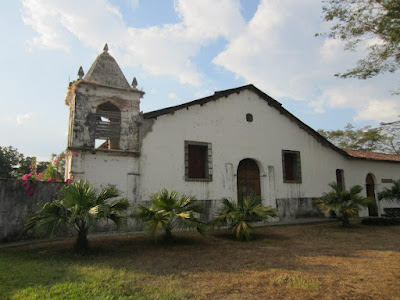 |
| The Peace Center (©2013 Linda Muth) Although I have been to the center more recently, I only have photos from an earlier visit. |
Probably the most photographed treasure in Suchitoto is the parish church, dedicated to the Roman saint and martyr, Santa Lucía (Saint Lucy). The first church on the site is thought to have been made of thatch. It burned down in the late 17th century and was replaced with a clay and stucco structure. Construction of the current building began in 1853 (after Salvadoran independence and therefore post-colonial). Its style has baroque and rococo elements. The church was closed (at least to tourists) for a number of years in order to make structural repairs following the strong earthquakes of 2001.
 |
| Interior of Santa Lucía Church (©2013 Linda Muth) |
.jpg) |
| Interior of Santa Lucía Church (©2019 Tim Muth) |
 |
| Detail in Santa Lucía Church (photo likely taken by Deb Adams) |
The local government, community organizations and citizens in Suchitoto do a good job promoting tourism through print publications and online platforms. Local businesses encourage patrons to write reviews. Local guides and the Tourist Police are available to help. It's pretty easy to check out local restaurants online, which is how we found Casa 1800 for a sunset dinner.
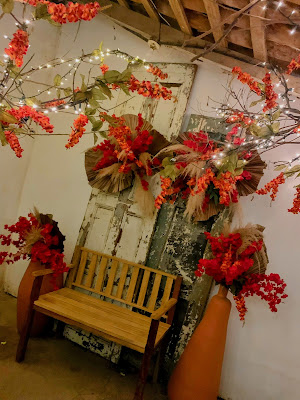 |
| The interior space of Casa 1800 included guest rooms, courtyards and large spaces for outdoor dining. (©2023 Linda Muth) |
Just in case you wish to visit Suchitoto during festival times, here are a few important dates to consider:
+ Celebration of the anniversary of the city: July 15
+ Corn festival and Balloon festival during the August 6th vacation week
+ Parade of Torches and Disguises in September
+ Independence Day parades and the school band festival (September 15)
+ Santa Lucía patron saint festivals December 6-13
 |
| Buenas noches, Suchitoto (©2019 Deb Adams) |
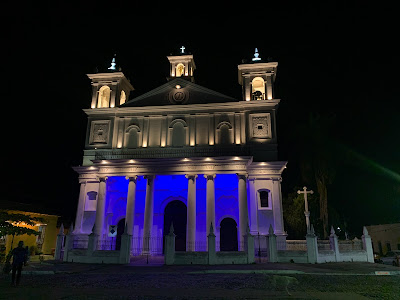


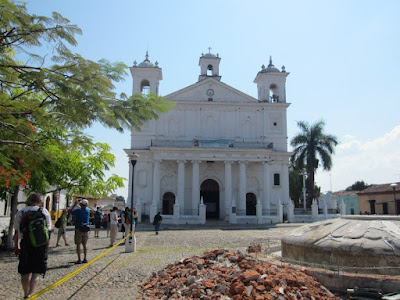






Comments
Post a Comment